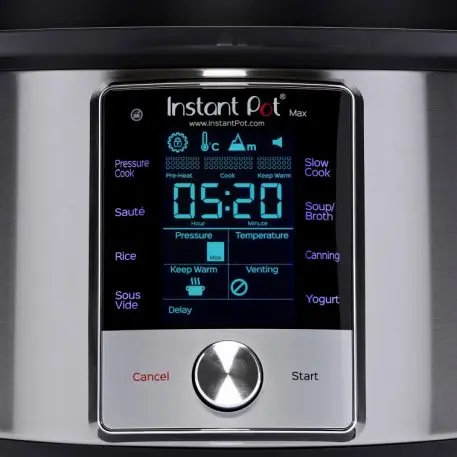Did America even cook before Amazon Prime Day in 2016, when the e-commerce giant unveiled the $70 Instant Pot? Hundreds of thousands of people bought the tabletop pressure cooker in a single a day, and legions of Instant Pot cookbooks appeared on shelves overnight. In the two years since, countless Instant Pot clones have popped up in attempts of dethroning the king.
Instant Pot’s name deserves no small amount of credit for its success. After all, it’s an electric pressure cooker. Pressure cookers have existed for decades. They operate under a relatively simple principle of physics, creating a chamber of pressure greater than our normal atmosphere, raising the boiling point of food and cooking it faster. But the term “pressure cooker” has a psychological weight. It conjures up images of a dangerous, hissing tool that can be turned into a makeshift bomb. Even the word “pressure” communicates the stress of an imminent explosion.
But Instant Pot? It sounds like a Monday night miracle that can cook you a Mississippi roast in 45 minutes flat. Likewise, its industrial design is nearly idiot-proof. Unlike conventional pressure cookers, which need to be monitored, the Instant Pot is set-and-forget. It made pressure cooking less scary in practice, not just in name.
Double Insight, the Canadian maker of the Instant Pot, isn’t content with simply introducing millions of people to pressure cooking, though. Today the company is debuting the most high-tech and expensive pressure cooker design yet, the$200 Instant Pot Max. I spoke to Double Insight VP and Instant Pot product lead Yi Qin to get a peek inside the surprisingly savvy design of a product that aims to change how we cook–again.

The cult product developer behind Instant Pot and Blackberry
In his past life, Qin was a technical lead at Blackberry. So perhaps it’s no surprise that a man responsible for the world’s most beloved smartphone covered in buttons now leads development on the world’s most beloved pressure cooker covered in buttons.
Qin is remarkably affable and self-aware. Addicted to user feedback, he personally scours comments on Amazon and other parts of the internet for information that could inform the next generation of his designs. He’s also incredibly secretive about the size, scope, and methodology of his internal development team, which he says has tripled within the past year.
One thing Qin wanted to tackle with the Max was the original Instant Pot’s infamous slew of buttons. To first-time users, it looks like a piano’s worth of cooking keys: There are buttons for poultry and yogurt, alongside sauté and pressure cook. The idea behind all those buttons, Qin explains, is to help users get cooking as quickly as possible. “You put stuff in there and you can cook,” he says. “It can lead the novice users through the door.”

There were a few problems with that approach to interaction design, though. It’s hard to know whether you should use a preset or a function, or what the differences between all those options and buttons really mean in practice. (Do most people really need a button that reads “Yogurt”?) And, Qin says, a vast majority of users soon hone in on just a few functions: pressure cooking, sautéing, and slow cooking. All of the other buttons are just in the way.
Qin built all sorts of experimental Instant Pots during the design process, but the Max couldn’t simply get rid of its buttons for voice or gesture control instead. That’s because the knowledge base of the Instant Pot community–and its library of recipes–are all built upon the standards established by those buttons. Changing the interface completely would mean invalidating the user base.
So instead, the excess was trimmed away, and the overall button count was reduced from 12 to 8. The visual hierarchy was also rethought–popular standards like pressure cooking and sautéing were moved into the top left corner, where your eye goes first. The buttons themselves are now connected to an LCD touch screen, with sub-settings that are adjustable with a tap rather than a knob. And in an extremely welcome touch, the Max uses a simple graphic data visualization to show how far it is in a cooking cycle, along with the temperature.
The interface is cleaner, simpler, and more easily adjusted. But yes, there’s still a yogurt button.

Psychoanalyzing Instant Pot users
Another challenge for the design team? Finding a way to make the Max feel safe. After all, knives can cut a finger. Ovens burn hands. But these are kitchen casualties that we’ve all grown to more or less accept because these tools have been part of our culture for so long. The Instant Pot is one of the safest pressure cookers ever made; unlike stove top cookers, the user cannot overheat it and make it explode.
Still, Qin’s challenge is as much about mitigating the perception of danger as much as any real danger.
“Being scared is one of the first things people post [online]. ‘I’m really scared. I don’t know how to use it.’ That’s probably a typical thing,” says Qin. “We are creating market education materials, but, on the other hand, the [Max] will be designed to be perceived as not as scary as the previous products.”
Mitigating the effects of steam was the biggest piece of this puzzle. Sooner or later, when you use an Instant Pot, you will release steam. And when you push a button on the lid to do so, a geyser of steam shoots out just inches away. “It’s more a psychological effect than an actual problem, when you see the steam venting out from the release,” Qin says. But that psychological effect is the stuff of trend pieces, and so the team wanted to solve it.
The new Max still needs to release steam, but a plastic lid now wraps itself around the steam vent–not eliminating the gush of steam, but shaping it into a more controlled column. A larger engineering effort was made to remove the steam vent button from the lid altogether. Now, you can release steam right from the Instant Pot’s touch screen instead–even programming the pot to automatically release steam at the end of a cycle–in a single plume, or in a series of staccato bursts.
To pull this off, Instant Pot’s engineers actually built a wirelessly controlled steam release valve into the cover. The insane part is that the valve is electric, but it has no wires leading to it. Instead, it sends energy wirelessly to pull off this feat–and you can still stick the lid in your dishwasher when you’re done. Imagine doing that to clean your iPhone. “It is crazy, but it is a design requirement,” says Qin. “All of our lids are supposed to be able to be washed in the dishwasher.”
After using the Max for several weeks, I’m still taken aback by the subtle genius of that valve, and how, by digitizing the mechanical experience, there is no way to ever leave the valve open by accident. But even more so, I’m convinced this mainstream gadget offers the tiniest glimpse into the future–a world where digital buttons, and mechanical actuators, are one in the same thing.
In the end, the Max is a lesson in balancing human-centered design and technology. It may have a wireless steam valve button, but it also has one for yogurt. There’s no room for error when it comes to user expectations of a hit product’s next generation.
Recognize your brand’s excellence by applying to this year’s Brands That Matter Awards before the final deadline, June 7.
Sign up for Brands That Matter notifications here.
